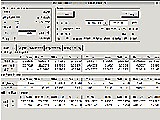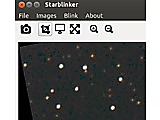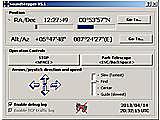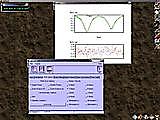 Gaia Sky is a real-time 3D Universe application that runs on Linux, Windows and macOS. It is developed within the framework of ESA's Gaia mission to chart more than 1 billion stars. A part of Gaia Sky is described in the paper Gaia Sky: Navigating the Gaia Catalog.
Gaia Sky is a real-time 3D Universe application that runs on Linux, Windows and macOS. It is developed within the framework of ESA's Gaia mission to chart more than 1 billion stars. A part of Gaia Sky is described in the paper Gaia Sky: Navigating the Gaia Catalog.
 A planetarium software that renders a 3D simulation of the night sky. * default catalogue of over 600,000 stars * extra catalogues with more than 177 million stars * default catalogue of over 80,000 deep-sky objects * extra catalogue with more than 1 million deep-sky objects * asterisms and illustrations of the constellations * constellations for 20+ different cultures * images of nebulae (full Messier catalogue) * realistic Milky Way * very realistic atmosphere, sunrise and sunset * the plane
A planetarium software that renders a 3D simulation of the night sky. * default catalogue of over 600,000 stars * extra catalogues with more than 177 million stars * default catalogue of over 80,000 deep-sky objects * extra catalogue with more than 1 million deep-sky objects * asterisms and illustrations of the constellations * constellations for 20+ different cultures * images of nebulae (full Messier catalogue) * realistic Milky Way * very realistic atmosphere, sunrise and sunset * the plane
 KStars is free, open source, cross-platform Astronomy Software. It provides an accurate graphical simulation of the night sky, from any location on Earth, at any date and time. The display includes up to 100 million stars, 13,000 deep-sky objects,all 8 planets, the Sun and Moon, and thousands of comets, asteroids, supernovae, and satellites. For students and teachers, it supports adjustable simulation speeds in order to view phenomena that happen over long timescales, the KStars Astrocalculator
KStars is free, open source, cross-platform Astronomy Software. It provides an accurate graphical simulation of the night sky, from any location on Earth, at any date and time. The display includes up to 100 million stars, 13,000 deep-sky objects,all 8 planets, the Sun and Moon, and thousands of comets, asteroids, supernovae, and satellites. For students and teachers, it supports adjustable simulation speeds in order to view phenomena that happen over long timescales, the KStars Astrocalculator
 NDI is a standard for astronomical instrumentation control. INDI Library is an Open Source POSIX implementation of the Instrument-Neutral-Device-Interface protocol. INDI core library is composed of the following components: INDI Server. INDI Core Drivers: Hardware drivers that communicate with the equipment. Many devices are supported including: Mounts CCDs, CMOS, Webcams, DSLRs (Canon, Nikon, Sony, Pentax..etc). Focusers. Filter Wheels. Adaptive Optics. Domes.
NDI is a standard for astronomical instrumentation control. INDI Library is an Open Source POSIX implementation of the Instrument-Neutral-Device-Interface protocol. INDI core library is composed of the following components: INDI Server. INDI Core Drivers: Hardware drivers that communicate with the equipment. Many devices are supported including: Mounts CCDs, CMOS, Webcams, DSLRs (Canon, Nikon, Sony, Pentax..etc). Focusers. Filter Wheels. Adaptive Optics. Domes.
 Siril is an astronomical image processing tool. It is specially tailored for noise reduction and improving the signal/noise ratio of an image from multiple captures, as required in astronomy. Siril can align automatically or manually, stack and enhance pictures from various file formats, even image sequence files (films and SER files). It works well with limited system resources, like in embedded platforms, but is also very fast when run on more powerful computers. Contributors are welcome. Prog
Siril is an astronomical image processing tool. It is specially tailored for noise reduction and improving the signal/noise ratio of an image from multiple captures, as required in astronomy. Siril can align automatically or manually, stack and enhance pictures from various file formats, even image sequence files (films and SER files). It works well with limited system resources, like in embedded platforms, but is also very fast when run on more powerful computers. Contributors are welcome. Prog
 GNU Astronomy Utilities (Gnuastro) is an official GNU package consisting of various programs and library functions for the manipulation and analysis of astronomical data. All the programs share the same basic command-line user interface for the comfort of both the users and developers. Gnuastro is written to comply fully with the GNU coding standards so it integrates finely with the GNU/Linux operating system. This also enables astronomers to expect a fully familiar experience in the source code
GNU Astronomy Utilities (Gnuastro) is an official GNU package consisting of various programs and library functions for the manipulation and analysis of astronomical data. All the programs share the same basic command-line user interface for the comfort of both the users and developers. Gnuastro is written to comply fully with the GNU coding standards so it integrates finely with the GNU/Linux operating system. This also enables astronomers to expect a fully familiar experience in the source code
 XEphem is an interactive astronomy program for all UNIX platforms, written and maintained by Elwood Downey over more than thirty years 1990–2021 and now generously released under the MIT License.
XEphem is an interactive astronomy program for all UNIX platforms, written and maintained by Elwood Downey over more than thirty years 1990–2021 and now generously released under the MIT License.
 Cosmonium is a 3D astronomy and space exploration program. With Cosmonium you can navigate in our solar system and discover all the planets and their moons. You can also visit the neighboring stars and discover the true size of our galaxy and the Universe. Cosmonium supports (or will support) the creation of fictional planets, stellar systems nebulaes, ... using procedural generation.
Cosmonium is a 3D astronomy and space exploration program. With Cosmonium you can navigate in our solar system and discover all the planets and their moons. You can also visit the neighboring stars and discover the true size of our galaxy and the Universe. Cosmonium supports (or will support) the creation of fictional planets, stellar systems nebulaes, ... using procedural generation.
 The Cross Platform SEP-based Star Extractor and Astrometry.net-Based Internal Astrometric Solver An Astrometric Plate Solver for Mac, Linux, and Windows, built on Astrometry.net and SEP (SExtractor) Meant to be an internal library for use in a program like KStars for internal plate solving on all supported operating systems
The Cross Platform SEP-based Star Extractor and Astrometry.net-Based Internal Astrometric Solver An Astrometric Plate Solver for Mac, Linux, and Windows, built on Astrometry.net and SEP (SExtractor) Meant to be an internal library for use in a program like KStars for internal plate solving on all supported operating systems
 wxEphe displays Astronomical Ephemeris for The Sun, The Moon, and solar system planets, given date and observer's location.
wxEphe displays Astronomical Ephemeris for The Sun, The Moon, and solar system planets, given date and observer's location.
 Starblinker is a supernova search tool. It allows you to easily search for new stars in your astronomical photos. If you find a new star in your image, keep in mind that it could be a defect in your photo, like a hot pixel, or: 1) An already known or a new unknown asteroid; 2) An already known or a new unknown comet; 3) An already known or a new unknown galactic nova; 4) If it is superimposed to an external galaxy, an already known or a new unknown supernova; Before reporting a potential new di
Starblinker is a supernova search tool. It allows you to easily search for new stars in your astronomical photos. If you find a new star in your image, keep in mind that it could be a defect in your photo, like a hot pixel, or: 1) An already known or a new unknown asteroid; 2) An already known or a new unknown comet; 3) An already known or a new unknown galactic nova; 4) If it is superimposed to an external galaxy, an already known or a new unknown supernova; Before reporting a potential new di
 SoundSteper is a software-only control tool for step motors used with telescopes. It works in real-time, operates over a sound card, and requires an analog sound amplifier, works with up to 4 moters in parallel; provides sync and go-to modes or joystick control even. It runs on Windows.
SoundSteper is a software-only control tool for step motors used with telescopes. It works in real-time, operates over a sound card, and requires an analog sound amplifier, works with up to 4 moters in parallel; provides sync and go-to modes or joystick control even. It runs on Windows.
 Nightfall is an astronomy application for science, education, and fun. It can produce animated views of eclipsing binary stars, calculate synthetic lightcurves and radial velocity curves, and eventually determine the best-fit model for a given set of observational data of an eclipsing binary star system. Nightfall comes with a user guide, and a set of observational data for several eclipsing binary star systems.
Nightfall is an astronomy application for science, education, and fun. It can produce animated views of eclipsing binary stars, calculate synthetic lightcurves and radial velocity curves, and eventually determine the best-fit model for a given set of observational data of an eclipsing binary star system. Nightfall comes with a user guide, and a set of observational data for several eclipsing binary star systems.
 SkyChart draws an observable night sky of stars and nebulas from its catalog. It can also note the position planets, comets or asteroids. Many parameters allow automatic catalog selection, adapting colorization and dimensions, labels for non-star objects.
SkyChart draws an observable night sky of stars and nebulas from its catalog. It can also note the position planets, comets or asteroids. Many parameters allow automatic catalog selection, adapting colorization and dimensions, labels for non-star objects.
|